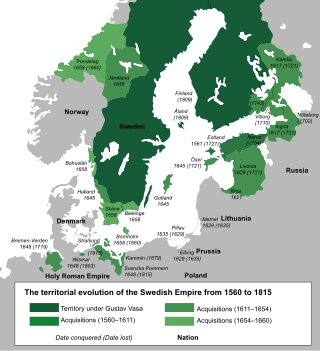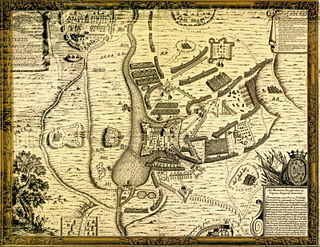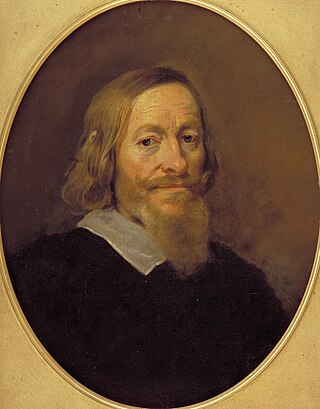
This is a list of possessions of Sweden held outside of Sweden proper during the early modern period.

This is a list of possessions of Sweden held outside of Sweden proper during the early modern period.
Fiefs that were held for a limited time.

Cities, held outside the realm, where Swedish mints were established.

Charles X Gustav, also Carl Gustav, was King of Sweden from 1654 until his death. He was the son of John Casimir, Count Palatine of Zweibrücken-Kleeburg and Catherine of Sweden. After his father's death he also succeeded him as Pfalzgraf. He was married to Hedwig Eleonora of Holstein-Gottorp, who bore his son and successor, Charles XI. Charles X Gustav was the second Wittelsbach king of Sweden after the childless king Christopher of Bavaria (1441–1448) and he was the first king of the Swedish Caroline era, which had its peak during the end of the reign of his son, Charles XI. He led Sweden during the Second Northern War, enlarging the Swedish Empire. By his predecessor Christina, he was considered de facto Duke of Eyland (Öland), before ascending to the Swedish throne. From 1655 to 1657, he was also Grand Duke of Lithuania.

Frederick III was King of Denmark and Norway from 1648 until his death in 1670. He also governed under the name Frederick II as diocesan administrator of the Prince-Bishopric of Verden, and the Prince-Archbishopric of Bremen (1635–45).

The Dominions of Sweden or Svenska besittningar were territories that historically came under control of the Swedish Crown, but never became fully integrated with Sweden. This generally meant that they were ruled by Governors-General under the Swedish monarch, but within certain limits retained their own established political systems, essentially their diets. Finland was not a dominion, but a land of Sweden. The dominions had no representation in the Swedish Riksdag as stipulated by the 1634 Instrument of Government paragraph 46: "No one, who is not living inside the separate and old borders of Sweden and Finland, have anything to say at Riksdags and other meetings..."

Count Hans Christoff von Königsmarck, of Tjust was a German soldier who commanded Sweden's legendary flying column, a force which played a key role in the Swedish military strategy in the Thirty Years' War.

Swedish Livonia was a dominion of the Swedish Empire from 1629 until 1721. The territory, which constituted the southern part of modern Estonia and the northern part of modern Latvia, represented the conquest of the major part of the Polish-Lithuanian Duchy of Livonia during the 1600–1629 Polish-Swedish War. Parts of Livonia and the city of Riga were under Swedish control as early as 1621 and the situation was formalized in the Truce of Altmark 1629, but the whole territory was not ceded formally until the Treaty of Oliva in 1660. The minority part of the Wenden Voivodeship retained by the Polish–Lithuanian Commonwealth was renamed the Inflanty Voivodeship, which today corresponds to the Latgale region of Latvia.

The Deluge was a series of mid-17th-century military campaigns in the Polish–Lithuanian Commonwealth. In a wider sense, it applies to the period between the Khmelnytsky Uprising of 1648 and the Truce of Andrusovo in 1667, comprising the Polish theatres of the Russo-Polish and Second Northern Wars. In a stricter sense, the term refers to the Swedish invasion and occupation of the Commonwealth as a theatre of the Second Northern War (1655–1660) only; in Poland and Lithuania this period is called the Swedish Deluge, or less commonly the Russo–Swedish Deluge due to the simultaneous Russo-Polish War. The term "deluge" was popularized by Henryk Sienkiewicz in his novel The Deluge (1886).

The Second Northern War (1655–60), was fought between Sweden and its adversaries the Polish–Lithuanian Commonwealth (1655–60), the Tsardom of Russia (1656–58), Brandenburg-Prussia (1657–60), the Habsburg monarchy (1657–60) and Denmark–Norway. The Dutch Republic waged an informal trade war against Sweden and seized the colony of New Sweden in 1655, but was not a recognized part of the Polish–Danish alliance.

The Duchy of Courland and Semigallia was a duchy in the Baltic region, then known as Livonia, that existed from 1561 to 1569 as a nominally vassal state of the Grand Duchy of Lithuania and subsequently made part of the Crown of the Polish Kingdom from 1569 to 1726 and incorporated into the Polish–Lithuanian Commonwealth in 1726. On March 28, 1795, it was annexed by the Russian Empire in the Third Partition of Poland.

Bogusław Leszczyński, count of Leszno (1614–1659) from the Leszczyński Family of Holy Roman Empire counts, was a Polish noble (szlachcic) and politician from Wielkopolska region.

The Peace of Prague, dated 30 May 1635 Old Style, was a significant turning point in the Thirty Years' War. Signed by John George I, Elector of Saxony, and Ferdinand II, Holy Roman Emperor, the terms ended Saxony's support for the anti-Imperial coalition led by Sweden.

Swedish overseas colonies consisted of the overseas colonies controlled by Sweden. Sweden possessed overseas colonies from 1638 to 1663, in 1733 and from 1784 to 1878. Sweden possessed five colonies, four of which were short lived. The colonies spanned three continents: Africa, Asia and North America.

The Treaty of Stuhmsdorf, or Sztumska Wieś, was a treaty signed on 12 September 1635 between the Polish–Lithuanian Commonwealth and the Swedish Empire in the village of Stuhmsdorf, Poland, just south of Stuhm (Sztum).

The Russo-Polish War of 1654–1667, also called the Thirteen Years' War, Muscovite War of 1654-1667 and the First Northern War, was a major conflict between the Tsardom of Russia and the Polish–Lithuanian Commonwealth. Between 1655 and 1660, the Swedish invasion was also fought in the Polish–Lithuanian Commonwealth and so the period became known in Poland as "The Deluge" or Swedish Deluge.

The six-year Truce of Altmark was signed on 16 (O.S.)/26 (N.S.) September 1629 in the village of Altmark, in Poland,by the Polish–Lithuanian Commonwealth and Sweden, with helped by Richelieu's envoy Charnacé ending the Polish–Swedish War (1626–1629),and freeing Gustavus to enter the Thirty Years' War.

Ove Gjedde was a Danish nobleman and Admiral of the Realm. He established the Danish colony at Tranquebar and constructed Fort Dansborg as the base for the Danish settlement. He was a member of the interim government that followed the death of King Christian IV, which imposed restrictions by the Haandfæstningon his successor King Frederick III.

The early modern era of Polish history follows the Late Middle Ages. Historians use the term early modern to refer to the period beginning in approximately 1500 AD and lasting until around 1800.

The relations between Denmark and Sweden span a long history of interaction. The inhabitants of each speak related North Germanic languages, which have a degree of mutual intelligibility. Both countries formed part of the Kalmar Union between 1397 and 1523, but there exists an inherited cultural competition between Sweden and Denmark. From 1448 to 1790 the two kingdoms went to war against each other at nearly every opportunity; in more than one case a new king tried to prove his worth by waging war on the other country for little or no political reason. Eleven Dano-Swedish wars took place between 1521 and 1814.

Joachim Gersdorff was a Danish politician, from 1650 to 1660 Steward of the Danish Realm. It was Gersdorff who negotiated the Treaty of Roskilde on Denmark's part during the Second Northern War, a war he had himself been in favour of entering. Through this treaty, which was concluded in Roskilde on 8 March 1658 (NS), the eastern Danish provinces of Scania, Halland, Blekinge and Bornholm were ceded to Sweden.

Arka Noego was a war pinnace in the Polish–Lithuanian Commonwealth Navy that played an important role in two naval battles of the Polish–Swedish War (1626–29). Small, fast and lightly armed when compared to the impressive man-of-war galleons of the Swedish Navy, excellent leadership, a fine crew and aggressive marines combined to bring the Arka Noego into parity with her larger opponents. Major roles in two impressive victories followed in the fall of 1627.

The Dano-Dutch War was a colonial conflict between the Danes and Dutch over the control of European fortifications on the Gold Coast. Denmark-Norway, assisted by England, defeated the Dutch in various places, although Michiel de Ruyter retaliated against the English by recapturing all forts but Cape Coast. This forced the Royal African Company into bankruptcy, which started the Second Anglo-Dutch War.